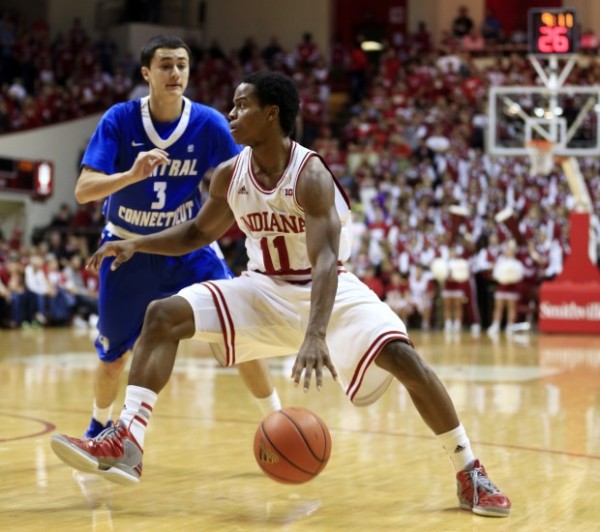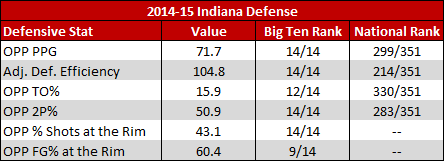Defense is the Only Thing Holding Indiana Back
Posted by Alex Moscoso (@AlexPMoscoso) on November 6th, 2015There’s not many programs out there that will be more interesting to follow this season than Indiana. For starters, Hoosiers’ head coach Tom Crean is on the hot seat. Given his team’s lofty preseason ranking (#15 in AP preseason poll) and icy relationship with a sizable portion of the Indiana fan base, the 49-year old head coach could find himself in the unemployment line in April if he fails to lead his team to an NCAA Tournament run this year. Luckily for him, Indiana is a team more than capable of doing such a thing, thanks to a high-powered offense (116.7 adjusted efficiency, ninth in the nation) that will be led by one of the best point guards in the country (Yogi Ferrell). Now entering his senior season, the two-time all-Big Ten performer looks to lead the Hoosiers back to how he found the program when he was freshman — capable of winning the Big Ten and becoming legitimate national title contenders.

Yogi Ferrell will need to lead the Hoosiers to play better defensively if he is to make a serious run in the NCAA Tournament in his final year. (Darron Cummings, AP)
Ferrell (16.3 PPG last season) is lucky to have talented players like James Blackmon, Jr. (15.7 PPG) and Troy Williams (13.0 PPG) on his wings. The trio fuels a frenetic uptempo offense (77.4 PPG) that can score in bunches against any team, but even with the addition of five-star center Thomas Bryant to man the post, the Hoosiers won’t go anywhere next March if they don’t improve their atrocious defense. There’s no nice way to put it: Last year’s defense — ranked 214th nationally, per KenPom — was an unmitigated disaster. It was an inexcusable display of ineptitude in almost every defensive area from a power conference team, as only four other NCAA Tournament teams had a worse defensive rating last season (all were #13 seeds or higher). The table below illustrates Indiana’s woeful play on the defensive end of the court.
To summarize, Indiana came in last in the Big Ten in both points allowed and efficiency. The most glaring statistical issues were failing to cause turnovers and allowing their opponents to find good shots too easily, but much of that is predicated on the Hoosiers’ weak interior defense. Indiana’s opponents took over 43 percent of their shots at the rim (the next closest in the Big Ten was at 37 percent), and the Hoosiers’ opponents shot over 60 percent when they got there. In a nutshell — too many easy buckets.
Last season’s small lineup (Indiana’s only true big man was Hanner Mosquera-Perea) certainly left the inside vulnerable, but it wasn’t just opponents’ big men who took advantage of their lack of size. Opposing guards regularly blew past Indiana’s poor perimeter defense to get to the cup with ease. The five Indiana guards who played the most minutes last season — Ferrell, Blackmon, Robert Johnson, Nick Zeisloft, and Collin Hartman — all sported an individual defensive rating over 108.0. This group would far too often let players penetrate inside for opportunities to embarrass them regardless of defensive scheme.
KenPom currently projects the Hoosiers to carry a defensive rating of 96.5 this year, but his preseason rankings are based more on the historical inertia of a program than individual players’ performances. So color me skeptical that this group can improve over eight points per 100 possessions in a single season. That said, turning this team into simply a serviceable defensive unit could rocket the Hoosiers into Big Ten contention. For example, if Indiana had logged an adjusted defensive efficiency rating of merely 100.0 last season –something every Big Ten team besides Rutgers and Northwestern managed to do — the Hoosiers would have jumped from #53 to #26 in last year’s overall KenPom ratings. Given the talent and athleticism that Crean has available on this year’s squad, he should be able to figure out how to motivate his defense into general competence. Otherwise, it likely won’t just be Ferrell who will not be returning to Bloomington next season.













































